Today we are going to review the Dell OptiPlex 7000 series. This is Dell’s Alder Lake 1L-class PC that is designed for corporate desktops. In our review, we are going to focus on some of the interesting aspects and critique a number of parts of Dell’s design as we go in-depth into the system. Let us get to it!
Project TinyMiniMicro Background
In Project TinyMiniMicro we are purchasing a large number of these devices from different sources. While a standard STH review is of a new product, these TMM nodes occasionally have specs that differ from what one would expect. In all of these pieces, we are going to talk about what makes the nodes unique. We are now well over 40 different nodes to increase diversity. We are testing these on a more circular economy/ extended lifecycle basis to see how they can be deployed after their initial use as corporate desktops. As always, we have a video version of this article.
We recommend opening this video in a YouTube tab, window, or app for a better viewing experience.
This configuration, at the time of publishing, is just over $2200 list, and $1475 after standard discounts, but before tax and shipping. For that, we had configured a Intel Core i7-12700, 16GB of DDR5 memory (2x 8GB), WiFi 6E, and a 512GB NVMe SSD.
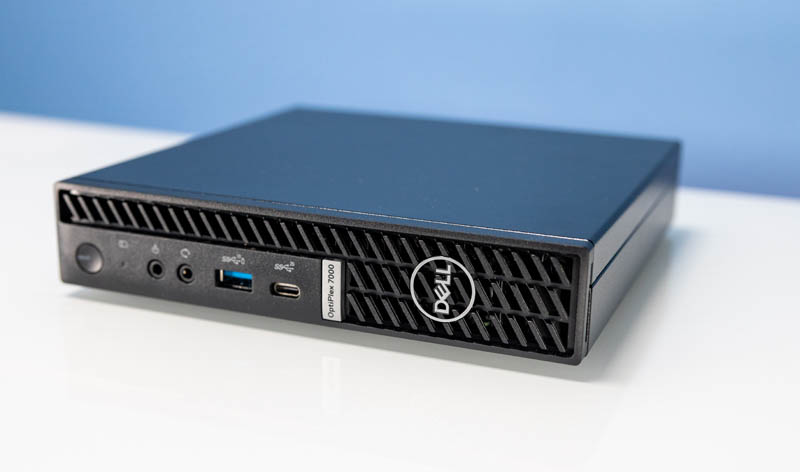
A quick word here, the $1475 is out of our normal Project TinyMiniMicro budget. We actually have a HP EliteDesk system with a NVIDIA dGPU that was less than this system. In order to get this system tested, Dell reached out to us to review the system, and I agreed. As a quick point of disclosure, Dell typically pays review organizations to license awards. That mechanism allows review organizations to not say their review is sponsored but allows Dell to compensate review sites for their time. At STH, as of this writing, we have never participated in that program. While Dell sent us this unit for review, we are able to do our normal critical review of the product since Dell knows it is unlikely to get an award (our Editor’s Choice award is given to <4 products/ year.) This is different than many of our TinyMiniMicro reviews where we have purchased units, but Dell’s pricing on these is high enough that this was the option to get this system reviewed.
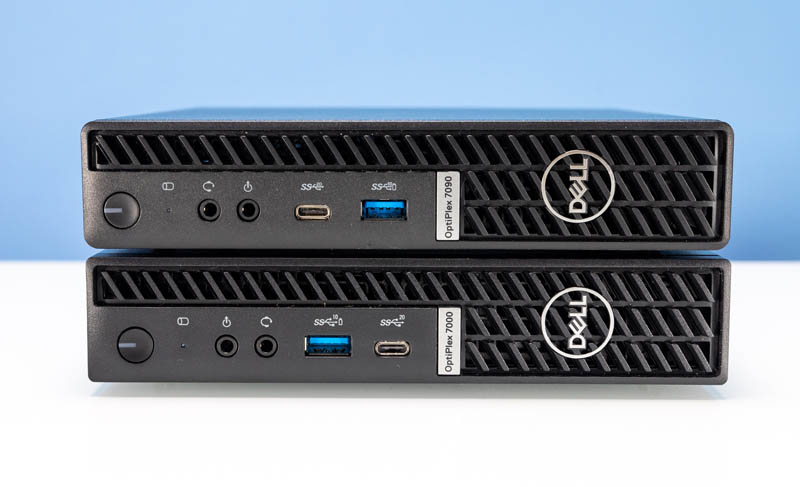
Project TinyMiniMicro has been a fun series for STH. This is perhaps the most interesting innovation in the series in many years with Intel Alder Lake processors. They have changed the game in terms of power consumption. With that, let us get to the hardware.
Dell OptiPlex 7000 Micro External Hardware Overview
On the front of the system, we have a layout that Dell has used previously. There is a power button, line out, headset jack, and two USB ports. Having the two audio jacks is probably a class-leading solution for audio. The USB is great with a 10Gbps Type-A and a 20Gbps Type-C port.
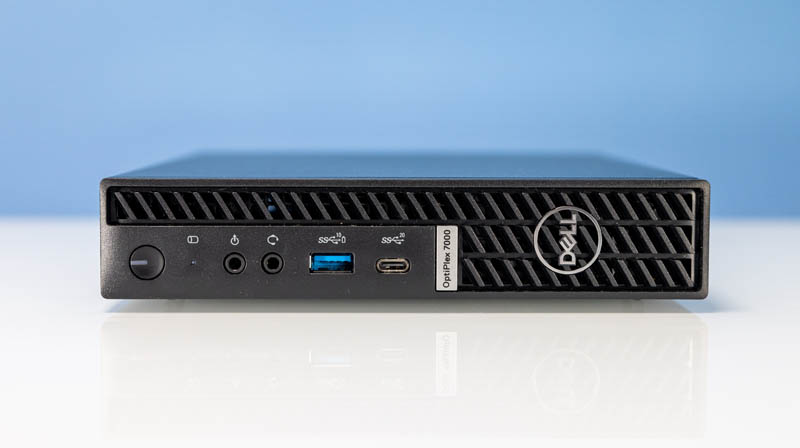
The other fun part of this is that Dell made a change several generations ago that has an interesting impact on the system. The Dell logo in older generations like the Dell OptiPlex 7060 Micro actually rotated so that it could be aligned in vertical or horizontal orientations. The current design has the Dell logo, OptiPlex 7000, headset/ line out, and HDD labels all oriented for vertical orientation. The USB labels are designed for horizonal orientation. There is a portion of the population that will not be able to un-see that and these systems are designed for mass appeal.
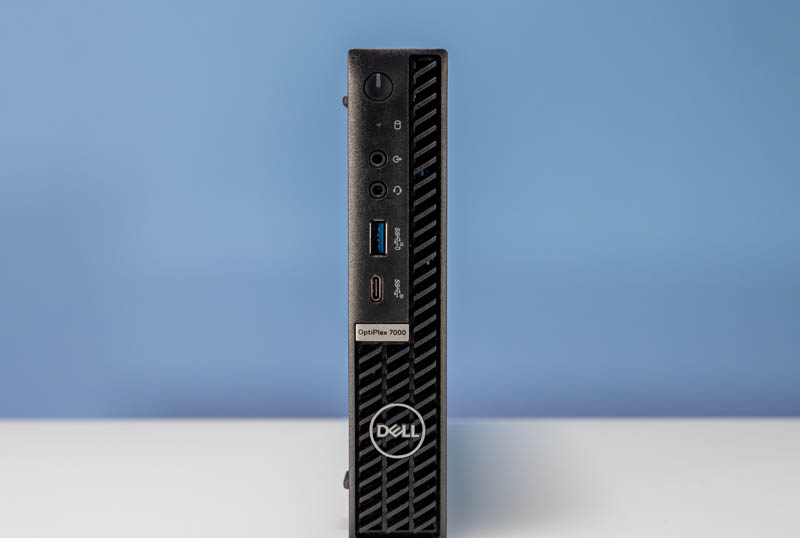
One other interesting part is that the front may look similar to, but it is a bit different from what we saw in our Dell OptiPlex 7090 Micro Review. We have the same port configuration but in a slightly different order. This is one of those where it is just a bummer that Dell could not keep the same port order. When these systems are deployed, IT organizations will have to do a little bit more re-work on existing documentation to update for this difference. Plus, it makes stacks less uniform, as can be seen below.

On the rear, we get three DisplayPorts. We also get three USB 3 Type-A ports. One is a 5Gbps port and two are 10Gbps ports. A quick thank you to the Dell engineers for just putting the speed number next to the port (5, 10, or 20) to indicate the speed. It seems as though Dell has found a better solution for USB naming.
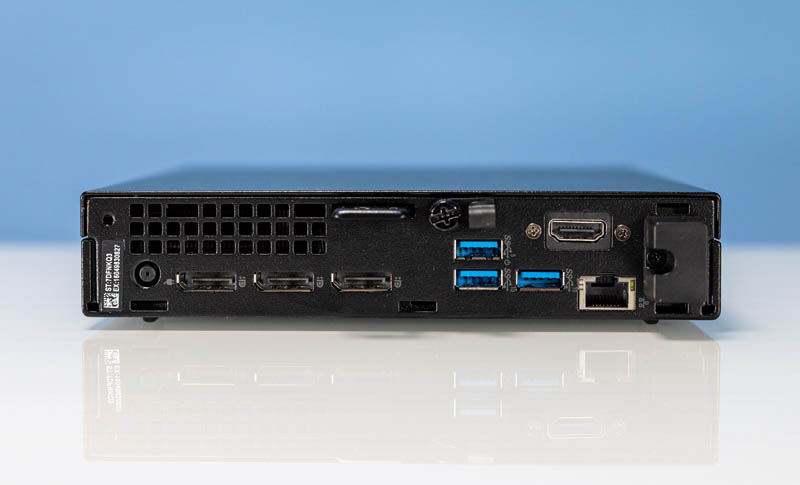
On the right, we also get a HDMI optional port. There are options here for things like VGA, DisplayPort, and etc., but we did not see a 2nd NIC option listed as companies like HP have. The NIC is a 1GbE NIC still. The box on the edge is the WiFi antenna area.
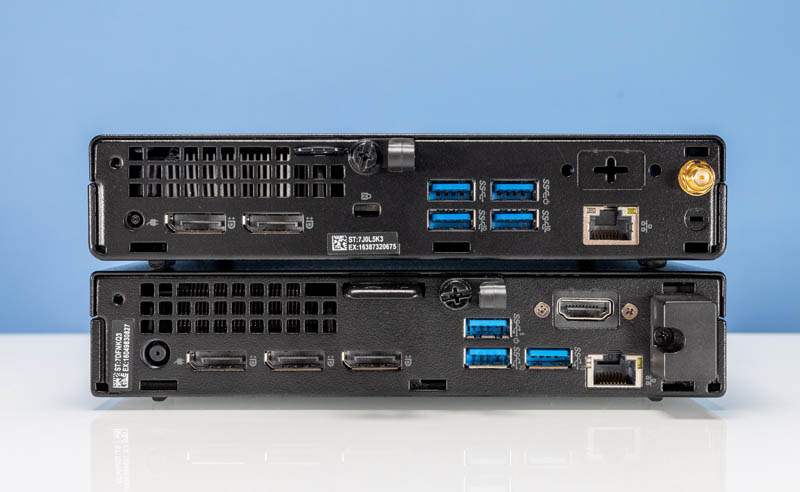
Doing a quick comparison to the OptiPlex 7090 Micro, we can see that the previous generation we looked at has another USB port but one less DisplayPort. In the OptiPlex 7000 series, it seems like the 35W version also has 2 DP, 4x USB on the rear. It is too bad there is not more uniformity here.
Next, let us get to the internal hardware overview.

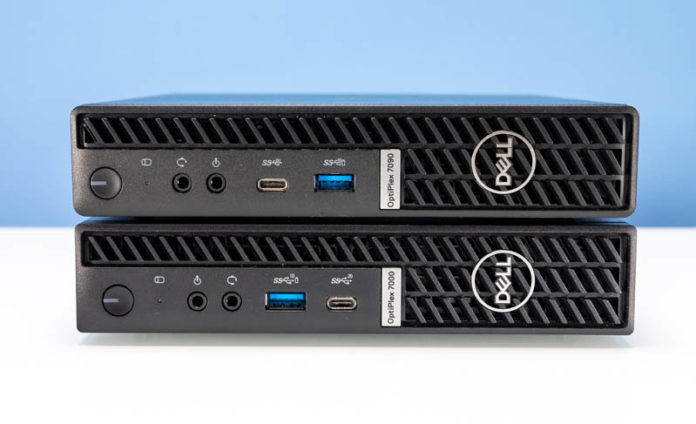



Pat that SSD is actually just a OEM 980 Pro. So it’s pretty much top bin from Samsung
Once you factor in that power brick I think I prefer the next size up (small form factor). Slightly bigger package if compared to micro+power brick but you get internal power supply and half height expansion slot.
Dave – that is totally the case. Note the thermal results of the SSD.
Nice review. I wonder which tpm chip is used? Taiwan?
Pat – Right! I realized that was the results because it’s throttling.
Hello Pat, appreciate the great write up as usual. Just curious if you had a second m.2 NVMe SSD and was able to get it to detected in AHCI mode? Thank you!
No option for 2.5/5/10gig ethernet in 2022? feels like a limitation, esp compared to 2018 mac mini.
Dell should make a Ryzen 7000 version. Ditto altmind’s call for 10Gb.
I thought these were all the low power “T” variants?
This one appears to be i7-12700, but most I look at are i7-1200T.
I just love those small boxes for the idle vs. peak power they can deliver!
I’d have a couple of questions:
Does the BIOS support setting P1/P2/TAU so you can balance peak heat/noise better?
Is it worth trying to find a TDP setting that just stays shy of throttling or will throttle have the same effect?
My understanding was that the orignal throttling was rather drastic and would literally stop the clock for what could amount to milliseconds, whilst e.g. a Ryzen will simply lower the clock to the point where 90°C won’t be exceeded. Apart from noise issues the latter would certainly seem much better for not missing interrupts, real-timish audio/video playback or even avoiding dropped network packets.
While these units are obviously designed for desktop use, I am assuming your interest like mine is primarily in server use. But there at least one 10GBit Ethernet port or a Thunderbolt port to connect one would seem minimum to balance the speed and throughput these devices are capable of. Well in fact these should be able to hold their own even on 40Gbit…
With multiple USB 10Gbit ports and some even at 20Gbit, some sort of faster fabric seems urgently missing.
A product at that price point, shouldn’t be limiting the type-C port to just USB, but also include thunderbolt functionality.
Have anyone tried to run a raid card through the m.2 to PCIe raiser adapter?
Missing thunderbolt is for me a huge nono
Thunderbolt would allow an external gpu to take the heat and do more with the micro pc
I wonder who makes these devices without realizing they are missing something important
I recently go one 7050 pre- knowed after a few months it crash, timing settings . repeating shut down mode. Never recovered from the crash . retried to re-install window s 10 crash right after bootup. Trash . may inspiron 1400 laptop runs like a dream . faster than that tiny PC.